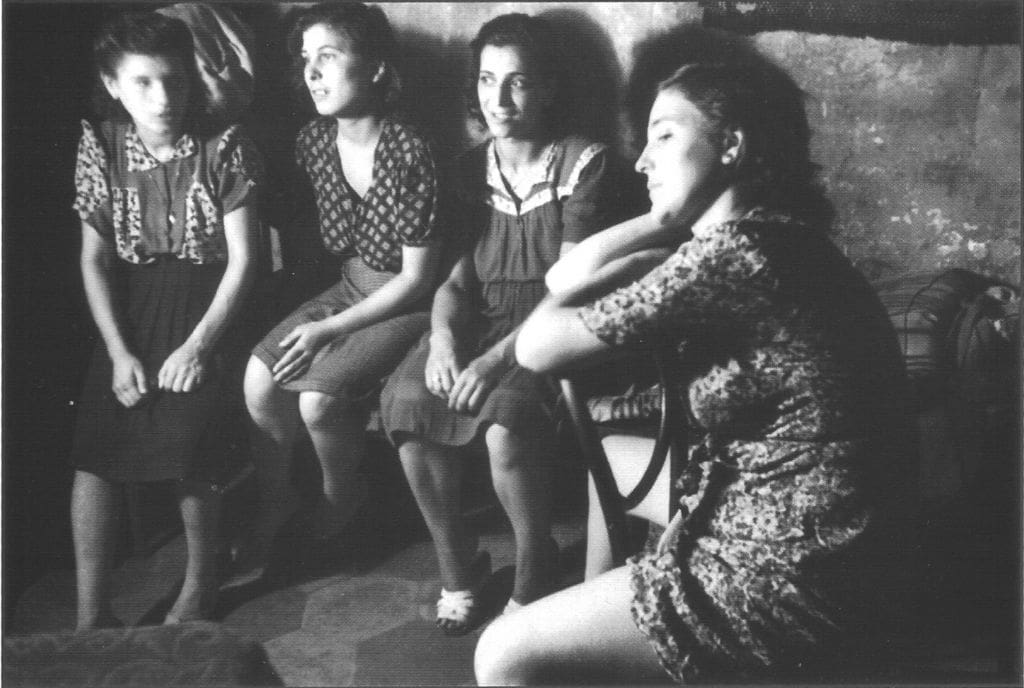The protection of families is still a central tenet of Christian-based politics, and this was no different in the interwar Horthy era. Family protection focused primarily on the fight against prostitution and abortion, besides battling drug abuse and pornography. The Hungarian Association Against the Trafficking of Girls (Magyar Egyesület a Leánykereskedelem Ellen, MELE),[i] which declared war on prostitution, was founded in the dualist era and was co-chaired by Catholic Bishop Ottokár Prohászka. Prohászka’s mission was to confront the ‘scourge’ of capitalism and to represent Christian social thought. In early 1920, the bishop gave a lecture at the Uránia Theatre, showing a series of images of ‘sewer people’, widows feeding on garbage, families living in public toilet rooms and little girl prostitutes.
MELE was a state-supported organisation working closely with the Christian churches, and from 1921 onwards it housed women caught by the police while engaging in illegal prostitution. The anti-Semitic propaganda of the time, of course, also blamed the Jews for prostitution: they ‘take Christian women to the Jewish market’, and even ‘their own women’, racialist publicist Lehel Kádár wrote.[ii] MELE was actually partly financed by the Jewish banker Leó Lánczy, but this fact was elegantly overlooked by the representatives of the racist social cause.
Prostitution was directly associated with Judaism in anti-Semitic propaganda.
In 1920, the racist newspaper Kecskemét és Vidéke referred to the ‘racially managed’ trading of girls,[iii] while in 1922, the Christian Socialist Nép explicitly stated that only Jews ran brothels in Hungary.[iv] A few years later, the paper published an article entitled ‘One hundred percent of prostitution is Jewish-managed.’ Endre Zsilinszky similarly believed that Jews had ‘monopolized’ the girl trade.[v] (This was of course before he became an anti-Nazi journalist and politician).
Interestingly, some literature has suggested that in some areas of Eastern Europe, local Jews were over-represented in the running of prostitution businesses.[vi] However, historical records do not seem to underpin that this would have been true for Hungary, either in terms of Jewish prostitution or in terms of Jewish prostitutes. Emil Schreiber, the deputy chief of police in Budapest, who was himself Jewish and had to retire in 1920 on account of his ancestry, summarized his experience with prostitution in a book, concluding that there were hardly any Jewish prostitutes according to police statistics.[vii] His view was not biased: according to a MELE publication, the number of prostitutes continued to increase until the 1930s, and between 1912 and 1934, the statistics the girls helped by the organisation – showed that 73.7 per cent of prostitutes were Roman Catholic, 15.5 per cent Protestant and 4.4 per cent Jewish.[viii] In the archival records of the trials of the madams and pimps brought to court in Budapest in the 1920s, not a single Jew was listed, and only one pimp was recorded as ‘Jewish-looking’.[ix]
Although it was convenient to blame Jews for prostitution, the phenomenon—and its conservative critique—persisted throughout the early twenties. In late 1920, the papal prelate Sándor Giesswein called the activities of the girl prostitutes in Hungary ‘white slavery’,[x] and in 1925, the government party MP István Strausz was forced to state that ‘the girl trade is not dying out in our new country; to our great shame, it has remained a permanent feature’.[xi] While at the end of 1920 there were 1,717 registered prostitutes working in Budapest, by 1921 there were already 2,022, in a total of 18 registered brothels. However, the exact number is not known, as most of the prostitutes worked illegally in the 6th and 7th districts. As for the number of illegal prostitutes, the police arrested 949 prostitutes in 1921 and 2,200 three years later. 55 per cent of the illegal prostitutes were girls aged 19–21 in 1921, but there were also 13-year-olds and a 12-year-old girl in 1920.
The underage girls were usually picked up by pimps around train stations and lured away with the promise of housing.
However, cases are also known where ‘families’ posted fake newspaper ads looking for children—and then sold the girls to brothels. In 1921, the Socialist newspaper Népszava ran a lengthy report on the issue of prostitution, including underage prostitution. According to the paper, it was a ‘serious social disease’ comparable to ‘an ulcer’ because of the government’s ‘ostrich policy’ on the matter. Dániel Geguss, the head of the children’s criminal court, told the paper that STDs were now common among girls aged 12–13. Of 357 underage girls brought in, 49 had undefined STDs, 11 had syphilis and two were pregnant. The paper also took a look at the minors arrested: they were ‘dirty, ragged, hungry’ boys and girls, ‘but also some wearing silk stockings of uncertain origin and blouses’.[xii]
In the countryside, the data from 1925 show far fewer registered prostitutes: in the rural towns there were officially a few dozen, at most 40-50 prostitutes. However, a different picture emerges immediately if we look at the number of prostitutes hospitalized in the big rural cities: in 1921, 139 in Debrecen (256 a year earlier!), 88 in Miskolc, 66 in Győr, but a year later the number rose to 113.[xiii] In Makó, where in 1921 there were no officially registered prostitutes, a local newspaper described the street prostitution situation in the summer of that years as ‘a shockingly populous’ population of prostitutes, who ‘came from all social classes’. They are assisted by a ‘whole host of procurers’, and if you ask for two addresses in a pub, they give you three: everything from elegant ladies working near the main square to women waiting in ‘dirty, filthy holes’.[xiv]
Gábor Doros estimated in 1930 that there were about 16,000 prostitutes working in Hungary in the 1920s. To put this figure into context, in 2010, 20,000 prostitutes were working in the Netherlands, now seen as the ‘prostitution paradise’ of Europe. According to the 1920 census, Hungary’s population was 7.6 million, which means that there was one prostitute for every 475 inhabitants. In 1921, a sexual act cost about 1,000 crowns. We know little about the income of brothels, but if we accept the statistics collected by Prohászka for July 1919 (the last months of the Soviet Republic),[xv] the income of a brothel employing ten girls was 100,000 crowns a month. In 1921, an average brothel earned about 470,000 crowns a month, or about four million forints at today’s prices. Considering the poverty of the time, this must be considered a huge sum.
The gap between reality and the striving for a pure Christian social life angered many conservative public figures in the Horthy era.
In his diary, Prohászka wrote that for Hungarian men, ‘using a prostitute is like drinking a cup of coffee’.[xvi] While his comment was written during the Communist period, Jesuit priest Béla Bangha’s 1921 critique was already describing the counter-revolutionary era: ‘Prostitution flourishes in Hungary.’[xvii] Antal Müller, the co-chairman of the Christian Municipal Party of Budapest, indignantly stated that if a foreigner were to ask in Budapest ‘where the results of our Christian Renaissance are’, ‘we would have very little to show’, because ‘today the image of Budapest, in the 14th or 15th month of the Christian rule, is that the [prostitutes] dare to come out into the streets not only at nightfall, but in broad daylight, at noon and 1 o’clock, when our schoolchildren are let home from school…The doorways, the streets, are full of lewd women, who use the most drastic language to seduce even the husband walking arm in arm with his wife.’[xviii] And this was by no means a far-right myth. According to one left-wing newspaper’s article, Rákóczi Road ‘is the market of love in Pest…crowds of women on the pavements: their pale faces painted and wearing forced smiles.’[xix] In 1921, prostitutes were punished 1,135 times for public indecency, as opposed to 1923, by which time that number jumped to 6,000.[xx]
The government in the early 1920s was apparently still in favour of controlled legalization. In 1920, by order of the Interior Ministry, several rural brothels were opened to limit the spread of venereal disease, and by the mid-1920s there were brothels in every major town outside Budapest, that is, 74 localities nationwide. The supply of necessary items and materials to brothels was facilitated by a 1920 decree of the Interior Ministry, which provided disposed public office equipment such as soap and medical alcohol. Yet there was undoubtedly a desire among some radical members of the Budapest administrative and law enforcement agencies to settle the prostitution issue once and for all. The abovementioned Antal Müller, for instance, proposed the deportation of all illegal prostitutes, an act he said was necessary to ‘keep the race pure’, and wanted brothels to be handed over to Hungarian refugees pouring into the capital from the territories lost as a result of the Trianon peace treaty of 1920. In addition, he also proposed that 50 per cent of registered prostitutes have their licences revoked immediately and women who were not looking actively for a decent job be sentenced to forced labour. [xxi] In a speech, the politician spoke out especially against prostitutes who spread venereal diseases. In fact, frequenting prostitutes was not without its dangers. According to Müller’s data, 60 per cent of illegal prostitutes suffered from venereal diseases.
The deportation of prostitutes and the establishment of forced labour camps for women naturally never happened. The interwar right-wing system in the end crushed much of the illegal prostitution and finally decided to close down brothels in 1928.
[i] Zsuzsa Bokor, ’Nők a nemzetben, nemzet a nőkben: A Magyar Egyesület a Leánykereskedelem Ellen eugenikai olvasata’, Socio, 2015, 86–100.
[ii] Private papers of Lehel Kádár.
[iii] Kecskemét és Vidéke, 17 Oct 1920.
[iv] A Nép, 28 Nov 1922.
[v] Nemzetgyűlési napló, vol. XIX (1922), 55.
[vi] Edward J. Bristow, Prostitution and Prejudice: The Jewish Fight Against White Slavery, 1870-1939, New York, Schocken, 1983, 113.
[vii] Emil Schreiber, A prostitució, Budapest, Patria, 1917, 97.
[viii] Gábor Doros, Küzdelem a prostitúció és a leánykereskedelem ellen, Budapest, MELE, 1935, 18, 143.
[ix] Budapest Főváros Levéltára, VII.18.d.25711.1925. 4.
[x] Nemzetgyűlési napló, vol. VI (1920), 298–300.
[xi] Nemzetgyűlési napló, vol. XXIX (1922), 236–237.
[xii] Népszava, 20 Aug 1921.
[xiii] Gábor Doros, Melly József, A nemi betegségek kérdése Budapesten. Második rész, Budapesti Statisztikai Közlemények 61/2, 1930, 799–801, 809, 813, 820, 848.
[xiv] Makói Kis Tükör, 12 July 1921.
[xv] Ottokár Prohászka, Soliloquia, vol. I, Budapest, Szent István Társulat, 1929, 319.
[xvi] Ákos Felsővályi (ed.), Prohászka Ottokár. Napló, vols. I–III, Székesfehérvár, Prohászka Baráti Kör, 2011–2013. 391. See online: http://www.ppek.hu/konyvek/Prohaszka_Ottokar_Naplo_1.pdf This line was censored in the interwar edition of the diaries.
[xvii] Magyar Kultúra, 1921, 23–24.
[xviii] Fővárosi Közlöny, 29 Oct 1920, 744–745.
[xix] Népszava, 22 July 1921.
[xx] Doros and Melly, A nemi betegségek kérdése Budapesten, 808.
[xxi] Fővárosi Közlöny, 29 Oct 1920, 744–745.








